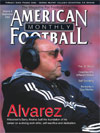AMERICAN FOOTBALL MONTHLY THE #1 RESOURCE FOR FOOTBALL COACHES
Article CategoriesAFM Magazine
|
The “B” WordMack Brown wouldn’t even mention it. Mark Mangino loves it. Coaches have found pros & cons to coaching football at “Basketball” schools.by: Richard Scott © More from this issue Five sure signs that you’re coaching football at a basketball school: 1. The booster groups insist on inviting the basketball coach to your summer kickoff functions. 2. The basketball coach’s line for autographs outnumbers your line 10 to 1. 3. The basketball staff has a nice spacious office set-up up high in coliseum. You and your staff are stuck in the basement. 4. Fans leave at halftime of the football games to make sure they have good seats to watch the first public scrimmage of the basketball season. 5. If the football team is hovering around .500 (or worse) at midseason, the most popular phrase in town is “at least it’s basketball ....The full article can only be seen by subscribers. Subscribe today!
|
|
|||||||
| HOME |
MAGAZINE |
SUBSCRIBE | ONLINE COLUMNISTS | COACHING VIDEOS |
Copyright 2025, AmericanFootballMonthly.com
All Rights Reserved





